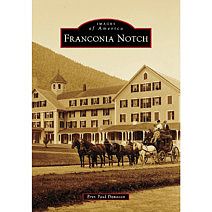Forgotten Woodstock, New Hampshire – Chartered in September 1763 by Governor Benning Wentworth, the town of Woodstock was first incorporated as Peeling. The charter, consisting of 25,000 acres, was granted to Eli Demerit and others and was divided into ninety-eight equal shares. In 1771, the land was regranted to Nathaniel Cushman and others and divided into seventy equal shares and renamed Fairfield. Then in 1773, it was regranted as Peeling back to some of the original proprietors. The name was changed to Woodstock in 1840.
Today the mountainous landscape of Woodstock is picture perfect. And the village of North Woodstock gets so much recognition that you would think North Woodstock received its own charter. But it didn’t and is part of the Woodstock charter. Much of the town's history is well known, but some of it has been forgotten. And this blog article focuses on a few of the forgotten historical features of Woodstock.
Remnants of Peeling on Mt Cilley, the original location of Woodstock, can still be found today. Stonewalls line the old village road, and cellar holes (above) are scattered throughout the forgotten Mt. Cilley Settlement. The Peeling Settlement was abandoned by the 1860s. And Woodstock's town center was moved to its current location.
During the mid-1800s the Fisk and Norcross Company was cutting timber on land they owned in the Lincoln and Woodstock area, and they did log drives on the Pemigewasset River (above). The drives began in the Lincoln / Woodstock area, and the logs were floated down the Pemigewasset River to the Merrimack River, eventually ending up in Lowell, Massachusetts where they had a sawmill.
Log drives were done on two rivers in Woodstock. Above is the remnants of what is believed to be the upper reserve dam, “Little Dam”, on the Wild Ammonoosuc River. This log driving dam was used during the late 1800s and early 1900s by the Fall Mountain Paper Company, which later became the International Paper Company, to move logs to the Connecticut River.
During the late 1800s and early 1900s, railroad logging ruled the White Mountains, and the Gordon Pond Railroad and the Woodstock & Thornton Gore Railroad worked the Woodstock area. Owned by the Johnson Lumber Company, the Gordon Pond Railroad traveled into the Lost River Valley. And the terrain was so steep in Kinsman Notch that snubbing winches, steam donkeys, and other means were used to lower horses and logs down some of the sled roads.
The Civilian Conservation Corps (CCC) was a public work relief program in operation from 1933 to 1942. The CCC built roads, trails, and made many improvements to the White Mountains region during their existence. However, they are known mostly for planting millions of trees across America, which helped with reforestation. Above is the remnants of the CCC camp in North Woodstock.
Woodstock has at least a half of dozen forgotten waterfalls. During the early days of the White Mountains, these waterfalls were big tourist attractions. But today we refer to them as forgotten because there are hardly visited and the only mention of them is in old books. Above is the forgotten Jackman Falls on Jackman Brook.
Balance Rock (above) and Bell's Cascade on Gordon Pond Brook was another popular tourist attraction during the early days of the White Mountains. Today, you don’t hear much mention of either of these interesting features.
Today, the area surrounding Elbow Pond is undeveloped and attracts a wide variety of outdoor enthusiasts. But in the 1970s, before the area was added to the White Mountain National Forest, private cabins were located on Elbow Pond. This area was also part of the Gordon Pond Logging Railroad. Remnants of the cabin community and the old railroad can still be found around the pond.
Not forgotten, but an important piece of Woodstock history worth mentioning is the 1942 Bomber crash. On January 14, 1942, five weeks after the attack on Pearl Harbor, a Douglas B-18 Bolo Bomber crashed on Mount Waternomee. Out of seven crew members, five survived the crash and were able to remove themselves from the wreckage. The remaining two members died when the plane exploded.
Loon Pond Mountain Cascades (above) along Horner Brook is another forgotten waterfall in Woodstock. In the early days of White Mountains tourism, a trail leading to the summit of Loon Pond Mountain (Loon Mountain’s South Peak) went past these cascades. No trail leads to this cascade today.
To license any of the above images for usage in publications, click on the image. And you can view more photos of this New Hampshire town here.
Happy image making..
Connect with us on Facebook | Historic Information Disclaimer | Purchase Our EB&L Railroad Book
Bibliography:
Carpenter, Frank Oliver. Guide Book to the Franconia Notch and the Pemigewasset Valley. Boston, MA: The Stillings Press, 1898.
Donovan, Erin Paul. “B-18 Bomber Crash, Mt Waternomee.” ScenicNH Photography LLC, 02 Sept 2009, https://www.scenicnh.com/blog/2009/09/b-18-bomber-crash-mt-waternomee/.
New Hampshire State Papers, volume XXV, pages 643 to 648.
Owner of ScenicNH Photography LLC
Erin Paul is a professional photographer, writer, and author who specializes in environmental conservation and historic preservation photography mainly in the New Hampshire White Mountains. His work is published worldwide, and publication credits include: Appalachian Mountain Club, Appalachian Trail Conservancy, Backpacker Magazine, and The Wilderness Society.














This was awesome thank you for sharing!
Thank you Mary!
Woodstock is a great town to explore.
Thank You Erin for the history and beautiful pictures you do awsome work ,my grandson is going to be spending summer with us and i'm looking foward to showing him this settlement he likes history like this ,takes after his grandfather ,i wake up every day and live for the old days again Thanks
Thank you, Roland! I am glad you enjoy my work. The history of the White Mountains is incredible. And if we don’t share it with the young and old generation it will be forever forgotten. Your grandson will have a great time this Summer!